AFP Published May 26, 2024

WASHINGTON: A tiny Nasa satellite was launched on Saturday from New Zealand with the mission of improving climate change prediction by measuring heat escaping from Earth’s poles for the first time.
“This new information — and we’ve never had it before — will improve our ability to model what’s happening in the poles, what’s happening in climate,” Nasa’s earth sciences research director Karen St. Germain told a recent news conference.
The satellite, which is the size of a shoe box, was launched by an Electron rocket, built by a company called Rocket Lab, which lifted off from Mahia in the north of New Zealand. The overall mission is called PREFIRE.
The company is later to launch a similar satellite of its own.
PREFIRE mission to measure heat that poles release into space
They will serve to take infrared measurements far above the Arctic and Antarctic so as to measure directly the heat that the poles release into space. “This is critical because it actually helps to balance the excess heat that’s received in the tropical regions and really regulate the earth’s temperature,” said Tristan L’Ecuyer, a mission researcher affiliated with the University of Wisconsin, Madison.
“And the process of getting the heat from the tropical regions to the polar regions is actually what drives all of our weather around the planet,” he added.
With PREFIRE, Nasa aims to understand how clouds, humidity or the melting of ice into water affects this heat loss from the poles.
Until now the models that climate change scientists used to gauge heat loss were based on theories rather than real observations, said L’Ecuyer.
“Hopefully we’ll be able to improve our ability to simulate what sea level rise might look like in the future and also how the polar climate change is going to affect the weather systems around the planet,” he added.
Small satellites like this one were a low-cost way to answer very specific scientific questions, said St. Germain.
Larger satellites can be thought of as “generalists” and the small ones as “specialists”, she said. “Nasa needs both,” she added.
Published in Dawn, May 26th, 2024
To learn about a galaxy's evolution, you have to follow the carbon.

The interstellar clouds of distant, ancient galaxies are often filled with carbon. This means, if astronomers can trace and detect these patches of carbon, which they call neutral carbon absorbers, they can learn quite a lot about how galaxies evolve.
Yet, actually detecting neutral carbon absorbers — a process that typically involves findin
Sounds like a job for AI. Or, to be more precise, it sounds like a job for a deep neural network.
Specifically, researchers recently set a neural network to work on spectroscopic data of galaxies taken more than a decade ago — and discovered more than a hundred new galaxies with neutral carbon absorbers.
How did they do this? Well, before using a neural network, you first have to train it. Unfortunately, as we've discussed, there aren't enough known neutral carbon absorbers to adequately do that. So, instead of using real data, the researchers generated a batch of 5 million fictitious spectra and used them to teach the neural network about what to look for: patterns often too subtle for a human eye to spot.
Then, the researchers set their neural network loose on data from the Sloan Digital Sky Survey III. When they did so, they pinpointed neutral carbon absorbers in 107 galaxies previously not known to possess these features.
Breaking space news, the latest updates on rocket launches, skywatching events and more!Contact me with news and offers from other Future brandsReceive email from us on behalf of our trusted partners or sponsorsBy submitting your information you agree to the Terms & Conditions and Privacy Policy and are aged 16 or over.
Where do we go from here?
Carbon is an indicator of a certain stage of galactic evolution. Its presence indicates that a galaxy has undergone rapid change and has produced many elements heavier than hydrogen or helium. It's possible, these researchers believe, that the presence of carbon in a galaxy may indicate the development of a Milky-Way-like disk. And the newly determined carbon-containing galaxies date from about 10.8 billion years ago — relatively early in the universe’s history — which makes that fact rather interesting.
In many ways, astronomy is an ideal field within which to enlist the help of AI methods. Astronomers now find themselves dealing with vast mountains of data; it's too much for humans to sift through on any reasonable timeframe — let alone sift through in a manner that can find the very minute patterns they sometimes need.
RELATED STORIES:
— Scientists use AI to reconstruct energetic flare blasted from Milky Way's supermassive black hole
— Citizen scientists and AI take a cosmic cruise to discover 430,000 new galaxies
— Could AI find alien life faster than humans, and would it tell us?
"It is necessary to develop innovative AI algorithms that can quickly, accurately and comprehensively explore rare and weak signals in massive astronomical data," said Jian Ge, an astronomer at China’s Shanghai Astronomical Observatory, in a statement.
The authors published their work on May 14 in the journal Monthly Notices of the Royal Astronomical Society.
Join our Space Forums to keep talking space on the latest missions, night sky and more! And if you have a news tip, correction or comment, let us know at: community@space.com.
Rahul Rao
Contributing Writer
Rahul Rao is a graduate of New York University's SHERP and a freelance science writer, regularly covering physics, space, and infrastructure. His work has appeared in Gizmodo, Popular Science, Inverse, IEEE Spectrum, and Continuum. He enjoys riding trains for fun, and he has seen every surviving episode of Doctor Who. He holds a masters degree in science writing from New York University's Science, Health and Environmental Reporting Program (SHERP) and earned a bachelors degree from Vanderbilt University, where he studied English and physics.
Astronomers observe jet reorientation in 'Death Star' black holes
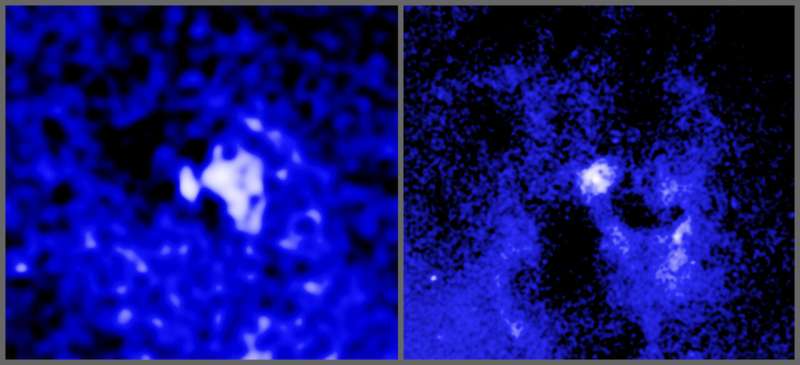
Huge black holes are firing powerful beams of particles into space—and then changing their aim to fire at new targets. This discovery, made using NASA's Chandra X-ray Observatory and the U.S. National Science Foundation (NSF) National Radio Astronomical Observatory's (NRAO) Very Long Baseline Array (VLBA), shows what kind of widespread impact black holes can have on their surrounding galaxy and beyond.
A team of astronomers looked at 16 supermassive black holes in galaxies surrounded by hot gas detected in X-rays by Chandra. The paper is published in The Astrophysical Journal.
Using radio data from the VLBA, they studied the directions of beams—also known as jets—of particles fired a few light-years away from the black holes. This gives the scientists a picture of where each beam is currently pointed, as seen from Earth. Each black hole fires two beams in opposite directions.
The team then used Chandra data to study pairs of cavities, or bubbles, in the hot gas that were created in the past by the beams pushing gas outwards. The locations of large outer cavities indicate the direction those beams pointed millions of years earlier. The researchers then compared the directions of the radio beams with the directions of the pairs of cavities.
"We found that about a third of the beams are now pointing in completely different directions than before," said Francesco Ubertosi of the University of Bologna in Italy, who led the study. "These Death Star black holes are swiveling around and pointing at new targets, like the fictional space station in Star Wars."
The X-ray and radio data indicate that the beams can change directions over nearly 90 degrees in some cases, and over timescales between one million years and a few tens of millions of years.
"Considering that these black holes are likely more than 10 billion years old," said co-author Gerrit Schellenberger of the Center for Astrophysics, Harvard & Smithsonian (CfA). "We consider a large change in direction over a few million years to be fast. Changing the direction of the giant black hole beams in about a million years is analogous to changing the direction of a new battleship in a few minutes."
Scientists think that beams from black holes and the cavities they carve out play an important role in how many stars form in their galaxies. The beams pump energy into the hot gas in and around the galaxy, preventing it from cooling down enough to form huge numbers of new stars. If the beams change directions by large amounts, they can tamp down star formation across much larger areas of the galaxy.
"These galaxies are too distant to tell if the beams from the Death Star black holes are damaging stars and their planets, but we are confident they are preventing many stars and planets from forming in the first place," said co-author Ewan O'Sullivan, also from CfA.
One of the biggest open questions is how these black hole beams turn like this. The direction of the beams from each of these giant black holes, which are likely spinning, is thought to align with the rotation axis of the black hole, meaning that the beams point along a line connecting the poles.
An important power source for these beams is likely matter in a disk spinning around the black hole and falling inwards. This process is thought to force the beams to be perpendicular to the disk. If material falls towards the black hole at a different angle that is not parallel to the disk, it could affect the direction of the black hole's rotation axis.
"It's possible that material rapidly falling towards the black holes at a different angle for long enough would drag their rotation axes in a different direction," said co-author Jan Vrtilek, also from CfA, "causing the beams to point in a different direction."
The team also considered alternative explanations for the mismatch between the directions of the radio beams and the cavities. One alternative is that gas is sloshing around in the cluster like wine in a glass being swirled in a circle. Sloshing like this might be caused by collisions between two clusters of galaxies that could move the cavities around.
However, the researchers found evidence of sloshing in both aligned and misaligned clusters, which argues against the possibility that sloshing is causing the cavities to move around large distances.
More information: Francesco Ubertosi et al, Jet Reorientation in Central Galaxies of Clusters and Groups: Insights from VLBA and Chandra Data, The Astrophysical Journal (2024). DOI: 10.3847/1538-4357/ad11d8
Journal information: Astrophysical Journal Provided by Chandra X-ray Center Astronomers spy quartet of cavities from giant black holes
NASA's Psyche fires up its sci-fi-worthy thrusters
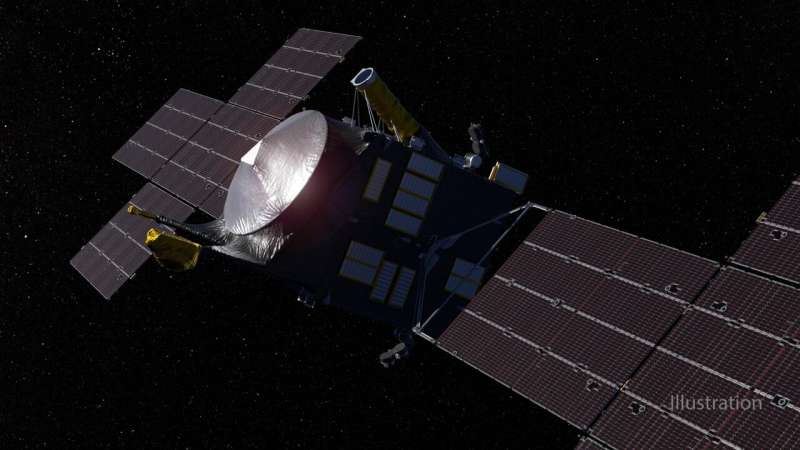
NASA's Psyche spacecraft passed its six-month checkup with a clean bill of health, and there's no holding back now. Navigators are firing its futuristic-looking electric thrusters, which emit a blue glow, nearly nonstop as the orbiter zips farther into deep space.
The spacecraft launched from NASA's Kennedy Space Center in Florida atop a SpaceX Falcon Heavy on Oct. 13, 2023. After leaving our atmosphere, Psyche made the most of its rocket boost and coasted beyond the orbit of Mars.
For the next year, the spacecraft will be in what mission planners call "full cruise" mode, when its electric thrusters take over and propel the orbiter toward the asteroid belt. The thrusters work by expelling charged atoms, or ions, of xenon, emitting a brilliant blue glow that trails behind the spacecraft.
They are part of Psyche's incredibly efficient solar electric propulsion system, which is powered by sunlight. The thrust created by the ionized xenon is gentle, but it does the job. Even in full cruise mode, the pressure exerted by the thrusters is about what you'd feel holding three quarters in your hand.
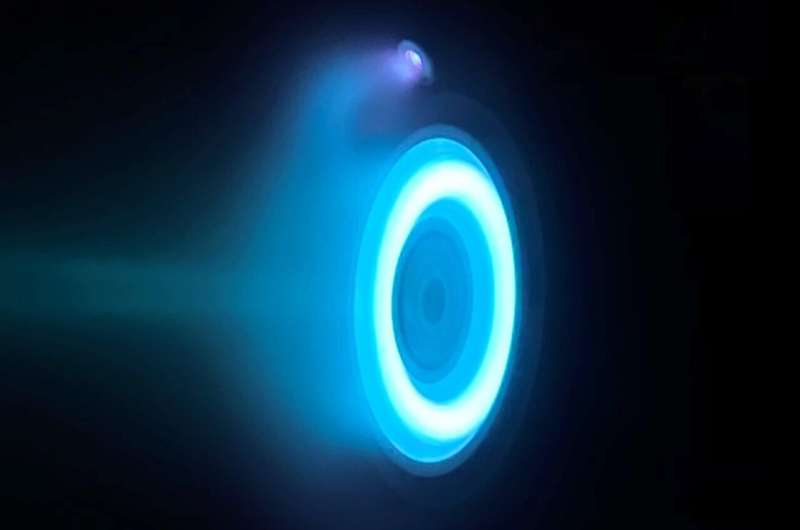
The orbiter is now more than 190 million miles (300 million kilometers) away and moving at a clip of 23 miles per second (37 kilometers per second), relative to Earth. That's about 84,000 mph (135,000 kph). Over time, with no atmospheric drag to slow it down, Psyche will accelerate to speeds of up to 124,000 mph (200,000 kph).
The spacecraft will arrive at the metal-rich asteroid Psyche in 2029 and will make observations from orbit for about two years. The data it collects will help scientists better understand the formation of rocky planets with metallic cores, including Earth. Scientists have evidence that the asteroid, which is about 173 miles (280 kilometers) across at its widest point, may be the partial core of a planetesimal, the building block of an early planet.
Clean bill of health
The flight team used Psyche's first 100 days in space to conduct a full checkout of all spacecraft systems. All of the engineering systems are working just as expected, and the three science instruments have been operating without a hitch.
The magnetometer is working so well that it was able to detect an eruption of charged particles from the sun, as did the gamma-ray and neutron spectrometer. And this past December, the twin cameras on the imaging instrument captured their first images.
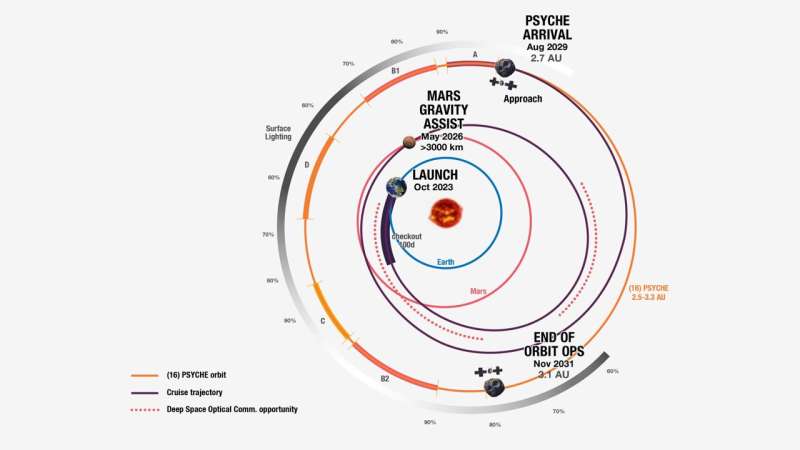
"Until this point, we have been powering on and checking out the various pieces of equipment needed to complete the mission, and we can report they are working beautifully," said Henry Stone, Psyche project manager at NASA's Jet Propulsion Laboratory in Southern California, which manages the mission.
"Now we are on our way and looking forward to an upcoming close flyby of Mars."
That's because the spacecraft's trajectory will bring it back toward the Red Planet in the spring of 2026. The spacecraft will power down the thrusters as it coasts toward Mars, using the planet's gravity to slingshot itself out. From there, the thrusters return to full cruise mode. Next stop: the asteroid Psyche.
In the meantime, the Deep Space Optical Communications technology demonstration aboard the spacecraft will keep on testing its mettle. The experiment already surpassed expectations when, in April, it transmitted test data from over 140 million miles (226 million kilometers) away at a rate of 267 megabits per second to a downlink station on Earth—a bit rate comparable to broadband internet download speeds.
Provided by NASA
NASA's heliophysics experiment to study the sun on European mission
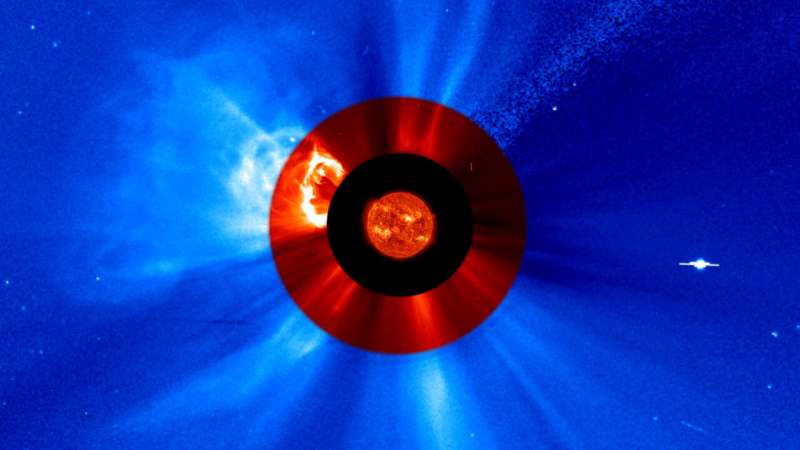
NASA announced Tuesday it selected a new instrument to study the sun and how it creates massive solar eruptions. The agency's Joint EUV coronal Diagnostic Investigation, or JEDI, will capture images of the sun in extreme ultraviolet light, a type of light invisible to our eyes but reveals many of the underlying mechanisms of the sun's activity.
Once integrated aboard the ESA's (European Space Agency's) Vigil space weather mission, JEDI's two telescopes will focus on the middle layer of the solar corona, a region of the sun's atmosphere that plays a key role in creating the solar wind and the solar eruptions that cause space weather.
The Vigil space mission, planned to launch in 2031, is expected to provide around-the-clock space weather data from a unique position at sun-Earth Lagrange point 5—a gravitationally stable point about 60 degrees behind Earth in its orbit. This vantage point will give space weather researchers and forecasters a new angle to study the sun and its eruptions.
NASA's JEDI will be the first instrument to provide a constant view of the sun from this perspective in extreme ultraviolet light—giving scientists a trove of new data for research, while simultaneously supporting Vigil's ability to monitor space weather.
"JEDI's observations will help us link the features we see on the sun's surface with what we measure in the solar atmosphere, the corona," said Nicola Fox, associate administrator, Science Mission Directorate at NASA Headquarters in Washington.
"Combined with Vigil's first-of-its-kind, eagle eye view of the sun, this will change the way we understand the sun's drivers of space weather—which in turn can lead to improved warnings to mitigate space weather effects on satellites and humans in space as well as on Earth."
European Space Agency selects two firms to build ISS cargo vehicle

The European Space Agency announced Wednesday it has selected two companies to develop a vehicle to transport cargo to the International Space Station by 2028, in a potential first step towards independent missions carrying astronauts.
The agency has recently struggled to find rockets to launch its missions into space, and is following in the footsteps of NASA by purchasing services from firms rather than developing them itself.
In November, the ESA launched a competition allocating up to 75 million euros ($80 million) to a maximum of three firms to build a vehicle to take cargo to the ISS and back.
Out of seven proposals, the ESA selected those from French-German The Exploration Company and French-Italian company Thales Alenia Space, each of which will receive 25 million euros, the agency's chief Josef Aschbacher told AFP.
"The evaluation is still ongoing," he said, adding that the ESA may yet select a third proposal.
The contracts, which run until June 2026, will focus on developing the technology and structure of the vehicles.
Additional funds for the ambitious plan would need to be approved by the ESA's 22 members states in 2025.
This would cover a mission planned by the end of 2028 to deliver cargo to the ISS and ensure its safe return to Earth.
It is the second major ESA contract for The Exploration Company—a start-up only launched in 2021—after it also won a bid to deliver cargo to US private developer Axiom Space's planned commercial space station.
Aschbacher signed contracts with The Exploration Company's CEO Helene Huby and Massimo Comparini from Thales Alenia Space at a space summit in Brussels on Wednesday.
The ESA faces soaring competition in the space sector, both from private firms such as Elon Musk's SpaceX and states like China and India.
It has also suffered a series of launcher setbacks, including Russia pulling its Soyuz rockets due to European sanctions over the Ukraine war.
Meanwhile the long-delayed first launch of the ESA's next-generation Ariane 6 rocket is now scheduled for the first half July, the agency said this week.
Also at the summit on Wednesday, the agency announced that 12 nations had signed onto its Zero Debris charter, which aims to reduce the amount of space junk building up around Earth.
Austria, Belgium, Cyprus, Estonia, Germany, Lithuania, Poland, Portugal, Romania, Slovakia, Sweden and the UK all signed up, the ESA said.
© 2024 AFP
Nou Systems, ExoAnalytic Solutions, TMC Design, HII Mission Technologies Corp, Parsons Government Services Inc, and Lockheed Martin were awarded six-month study contracts.
Sandra Erwin

WASHINGTON — The U.S. Space Force announced the selection of six companies to develop proposals for a electromagnetic warfare (EW) training range designed to simulate space combat scenarios.
In a statement May 22, the Space Force said this specialized environment will be crucial for training service personnel, known as guardians, to defend critical satellites and other spacecraft from electronic attacks. Satellites rely on electromagnetic signals for communication, navigation, and data transmission, making them vulnerable to jamming and cyberattacks.
The chief of space operations Gen. Chance Saltzman has stressed guardians need realistic training venues to hone their skills and prepare to counter the types of threats they might face in a contested domain.
The training range project is overseen by the Space Training and Readiness Command (STARCOM) and the Space Systems Command (SSC).
Six-month study contracts
Six companies — Nou Systems, ExoAnalytic Solutions, TMC Design, HII Mission Technologies, Parsons Government Services, and Lockheed Martin — in late February received six-month contracts for concept development.
The EW training range is part of a broader Space Force initiative called the Operational Test and Training Infrastructure (OTTI) program, managed by STARCOM and SSC. OTTI aims to establish a comprehensive training environment for guardians, encompassing high-fidelity simulators, virtual and augmented reality tools for immersive training experiences, and specialized facilities designed to test specific equipment and tactics.
The Space Force did not disclose the value of the contracts or the timeline for selecting a final design. According to the announcement, the studies focus on “risk reduction” effort as the Space Force implements the OTTI plan.
Andrew Jones

HELSINKI — China’s experimental reusable spacecraft has released an unknown object into orbit while conducting its third mission.
U.S. Space Force space domain awareness teams cataloged the object as 59884 (International designator 2023-195G). The suspected spaceplane launched Dec. 14, 2023 and has been in orbit 164 days. The object appears to have been released May 24.
Jonathan McDowell, of the Harvard-Smithsonian Center for Astrophysics and a space activity tracker, first flagged the event. He speculated on X, formerly Twitter, that the object could be a subsatellite deployment, or a piece of hardware ejected prior to end of mission and deorbit.
The object may also be used for proximity and capture maneuvers. The spaceplane used a released object to perform multiple recaptures as part of on-orbit testing during its second flight.
China has maintained strict secrecy around the mission. The country’s space authorities have not released images nor descriptions of the spacecraft. The only official Chinese report on the activity is a short launch report hours after the event.
“During this period, reusable technology verification and space science experiments will be carried out as planned to provide technical support for the peaceful use of space,” the report stated.
The spacecraft is seen as China’s attempt to develop similar capabilities to the X-37B. It is currently on its third mission. Reusable spacecraft represent a significant advancement in space technology, offering the potential for reduced costs and increased frequency of missions.
The Long March 2F rocket which launched the spacecraft has a payload capacity of just over eight metric tons to low Earth orbit. This suggests that the spacecraft could be somewhat similar in size and function to U.S. Air Force’s X-37B spaceplane.
This notion is reinforced by apparent images of the payload fairing wreckage recovered from the second launch and posted on the Sina Weibo social media site. The images give possible clues as to the dimensions and shape of the spacecraft.
The first flight, in 2020, lasted two days, while the second, launched in 2022, had a duration of 276 days. Both visits to orbit included the release of an object while in orbit.
The gap between the spacecraft’s first and second missions—launching in 2020 and 2022 respectively—was one year and 11 months. The third mission saw a seven-month turnaround.
| Mission | Launch Date | Landing Date | Duration | Time Since Previous Mission | Launch Site | Landing Site |
| Mission 1 | September 4, 2020 | September 6, 2020 | 2 days | N/A | Jiuquan spaceport | Lop Nur air base |
| Mission 2 | August 4, 2022 | May 8, 2023 | ~276 days | 1 year, 11 months | Jiuquan spaceport | Lop Nur air base |
| Mission 3 | December 14, 2023 | N/A | 164 days (ongoing) | 7 months, 6 days | Jiuquan spaceport | N/A |
The third flight has seen the spacecraft perform maneuvers to alter its orbit. The spacecraft entered an initial 333 by 348-kilometer-altitude orbit inclined by 50 degrees. U.S. Space Force space domain awareness data shows the spacecraft later raised its orbit, via a series of maneuvers, to a current orbit of 602 by 609 kilometers.
The reusable spacecraft may be the orbital segment which will operate in combination with a reusable suborbital first stage. A reusable suborbital spacecraft was tested for the first time in 2021. A second mission launched in August 2022. The suborbital craft uses a vertical takeoff and a horizontal landing.
The China Aerospace Science and Technology Corporation (CASC), the spacecraft’s developer, announced plans to develop a fully reusable, two-stage-to-orbit (TSTO) space transportation system prior to its first launch. CASC’s spaceplane project acquired national level funding from the Natural Science Foundation of China in 2022.
Meanwhile the U.S. Space Force X-37B spaceplane launched on its seventh mission Dec. 28 last year. Flying on a Falcon Heavy for the first time, space activity watchers suggest the spacecraft was sent to a highly elliptical, high inclination orbit, and to a much higher altitude than previous missions. The secretive and autonomous X-37B reusable vehicle began flights in 2010.
No comments:
Post a Comment